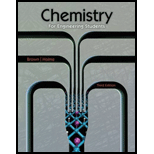
11.64 HBr is oxidized in the following reaction:
4 HBr(g) + O2(g) —• 2 H2O(g) + 2 Br,(g)
A proposed mechanism is
HBr + O2 -* HOOBr
(slow)
HOOBr + HBr — 2 HOBr
(fast)
HOBr + HBr — H2O + Bn
(fast)
- Show that this mechanism can account for the correct stoichiometry.
(a)
To determine:
Show that the given mechanism has correct stoichiometry.
Explanation of Solution
The molar ratio of the reactant molecules, products in a balanced chemical equation is called stoichiometry. Some reactions have so many steps to result in the final products. There can be intermediates which are not involved in the balanced equation. If a reaction has many steps to give their final products, by adding them together we can find the stoichiometric equation.
Here, we have shown only one
Then we can cancel out same molecule type present in the both side.
This reaction shows above mechanism can account for the correct stoichiometry.
But given reaction is
Therefore, mechanism matches the given stoichiometry.
(b)
To identify:
All the intermediates present in the mechanism.
Explanation of Solution
Some reactions should follow many steps to give their final product. In between these steps they will form intermediates. Intermediates don’t involve in the overall reaction. And final we can’t separate them out. Here,
(c)
To determine:
The molecularity of every elementary step.
Explanation of Solution
Molecularity of each step:
Molecularity is a theoretical concept and should not be negative, zero, fractional, infinite and imaginary. Molecularity is the total number of reactant molecules or atoms taking part in the chemical reaction.
Step 1 − molecularity is 2
Step 2 − molecularity is 2
Step 3 − molecularity is 2
(d)
To determine:
The rate expression for every elementary step.
Explanation of Solution
Rate equation:
Rate equation can be written using either product or reactants. If reactants are considered, we should take the reduction rate of reactants. If products are considered, we should take the growth rate of products.
(e)
To identify:
The rate determining step.
Explanation of Solution
Rate determining step:
Rate determining step is the slowest step in a chemical reaction. This step determines the rate of the whole reaction. So here rate determining step is step 1.
A reaction mechanism can contain more than one step and among them slowest step is considered as rate determining step. Rate expressions can be written to all the steps involved. It can be recognized whether a reaction mechanism matches with the correct stoichiometry to determine if the mechanism is correct.
Want to see more full solutions like this?
Chapter 11 Solutions
Chemistry for Engineering Students
- As with any drug, aspirin (acetylsalicylic acid) must remain in the bloodstream long enough to be effective. Assume that the removal of aspirin from the bloodstream into the urine is a lirst-order reaction, with a half-life of about 3 hours. The instructions on an aspirin bottle say to take 1 or 2 tablets every 4 hours. If a person takes 2 aspirin tablets, how much aspirin remains in the bloodstream when it is time for the second dose? (A standard tablet contains 325 mg of aspirin.)arrow_forwardAmmonium cyanate, NH4NCO, in water rearranges to produce urea, a common fertilizer, (NH2)2CO: NH4NCO(aq)(NH2)2CO(aq) The rearrangement is a second-order reaction. It takes 11.6 h for the concentration of NH4NCO to go from 0.250 M to 0.0841 M. (a) What is k for the reaction? (b) What is the half-life of the reaction when NH4NCO is 0.100 M? (c) How long will it take to rearrange 39% of a 0.450 M solution? (d) How fast is a 0.839 M solution being changed to urea?arrow_forwardCan a reaction mechanism ever be proven correct? Can it be proven incorrect?arrow_forward
- For the past 10 years, the unsaturated hydrocarbon 1, 3-butadiene (CH2 = CH - CH = CH2) has ranked 38th among the top 50 industrial Chemicals. It is used primarily for the manufacture of synthetic rubber. An isomer exists also as cyclobutene: The isomerization of cyclobutene to butadiene is first-order and the rate constant has been measured as 2.0104s1 at 150 C in a 0.53-L ?ask. Determine the partial pressure of cyclobutene and its concentration after 30.0 minutes if an isomerization reaction is carried out at 150 C with an initial pressure of 55 torr.arrow_forwardDerive an expression for the half-life of a a third order reaction;b a reaction whose order is =1; c a reaction whose order is 12. In these last two cases, examples are rare but known.arrow_forwardOzone in the stratosphere can be depleted in catalyzed reactions. The overall reaction for this exothermic process is given by: O3 +O→2O2, via the mechanism: NO+O3 →NO2 +O2 NO2 +O→NO+O2 Is this mechanism a chain reaction? Why or why not? Identify both the catalyst and the reactive intermediate in this mechanism. Draw to a relative scale the potential energy vs. reaction coordinate diagram for both the uncatalyzed reaction and the catalyzed reaction. Label transition states, activation energy, and reactive intermediates where appropriate.arrow_forward
 Chemistry & Chemical ReactivityChemistryISBN:9781133949640Author:John C. Kotz, Paul M. Treichel, John Townsend, David TreichelPublisher:Cengage Learning
Chemistry & Chemical ReactivityChemistryISBN:9781133949640Author:John C. Kotz, Paul M. Treichel, John Townsend, David TreichelPublisher:Cengage Learning Chemistry: Principles and PracticeChemistryISBN:9780534420123Author:Daniel L. Reger, Scott R. Goode, David W. Ball, Edward MercerPublisher:Cengage Learning
Chemistry: Principles and PracticeChemistryISBN:9780534420123Author:Daniel L. Reger, Scott R. Goode, David W. Ball, Edward MercerPublisher:Cengage Learning Principles of Modern ChemistryChemistryISBN:9781305079113Author:David W. Oxtoby, H. Pat Gillis, Laurie J. ButlerPublisher:Cengage Learning
Principles of Modern ChemistryChemistryISBN:9781305079113Author:David W. Oxtoby, H. Pat Gillis, Laurie J. ButlerPublisher:Cengage Learning Chemistry: Principles and ReactionsChemistryISBN:9781305079373Author:William L. Masterton, Cecile N. HurleyPublisher:Cengage Learning
Chemistry: Principles and ReactionsChemistryISBN:9781305079373Author:William L. Masterton, Cecile N. HurleyPublisher:Cengage Learning Chemistry: The Molecular ScienceChemistryISBN:9781285199047Author:John W. Moore, Conrad L. StanitskiPublisher:Cengage Learning
Chemistry: The Molecular ScienceChemistryISBN:9781285199047Author:John W. Moore, Conrad L. StanitskiPublisher:Cengage Learning Chemistry by OpenStax (2015-05-04)ChemistryISBN:9781938168390Author:Klaus Theopold, Richard H Langley, Paul Flowers, William R. Robinson, Mark BlaserPublisher:OpenStax
Chemistry by OpenStax (2015-05-04)ChemistryISBN:9781938168390Author:Klaus Theopold, Richard H Langley, Paul Flowers, William R. Robinson, Mark BlaserPublisher:OpenStax





